What Is Enterprise SEO?
Enterprise SEO is the implementation of SEO tactics by large organizations aiming to improve their visibility and ranking on search engine results pages (SERPs). This approach helps businesses that have very large websites with thousands (or millions) of webpages.
It typically involves scaling standard SEO techniques to meet the demands of extensive content, complex site architectures, and a broad organizational structure.
Enterprise SEO integrates three unique aspects:
- Content strategy: At the enterprise level, it’s crucial to do more than just have ample content. You should continuously tailor and update it to address your global audience’s diverse needs. This involves creating a scalable content strategy that supports SEO goals across different regions and languages.
- Technical SEO: Managing a large website requires overseeing its technical elements. This helps you to ensure all pages are optimized for fast loading times, mobile responsiveness, and error-free navigation. Such an approach includes regular audits and adjustments to keep up with search engine algorithm updates.
- Link building: Like content, link building should be about more than just quantity. Focus on building high-quality links that are relevant and authoritative. This approach can improve your company’s credibility and authority in its niche.
Targeting these components helps companies with large-volume websites achieve—and sustain—high search engine visibility.
What Is an Example of an Enterprise Website?
Enterprise SEO is vital for large-scale websites that require an advanced and strategic approach to manage their expansive digital footprint.
Here are a few types of websites that typically benefit from enterprise-level SEO due to their size, complexity, and the scale of their operations:
- Fortune 500 companies: Like Microsoft and Ford Motor Company
- Large ecommerce sites: Like Zappos and Wayfair
- Businesses with multiple locations: Like Starbucks and IKEA
- Enterprises with multiple websites: Like Apple
For example, Apple’s website has around 164 million indexed pages. This includes everything from product details and support articles to investor information and regional retail stores.
Handling SEO for such a large site requires meticulous attention to the technical aspects of SEO. Strategic content and link building should also align with global brand presence and market position.
While enterprise websites naturally have a broader reach, this doesn’t automatically translate to success in search rankings. But effective enterprise SEO leverages this potential to maintain a competitive edge.
What’s the Difference Between Enterprise SEO and Traditional SEO?
Enterprise SEO demands a level of scale and complexity that far exceeds that of traditional SEO.
Scaling
Scale is the primary differentiator in enterprise SEO because it impacts almost every aspect of an enterprise marketing strategy.
For example—internal linking practices.
Strategic internal linking (carefully placing links within a website to guide visitors) can significantly improve SEO on small websites. However, on a huge enterprise site like Apple—with millions of pages—the scale of implementing this method can be daunting.
To handle this strategy on a large scale, marketers need a systematic approach—like automation.
Instead of manually adding links to each page, using automated tools can streamline the process. These tools can automatically identify relevant content and insert links across thousands of pages efficiently.
This method not only saves time but also helps enhance SEO performance across large enterprise websites.
SEO Tools
Enterprise SEO tools are more sophisticated than those for traditional SEO. And often need custom solutions or advanced plans.
Take Semrush’s pricing, for example. There’s a plan for large businesses and enterprises.
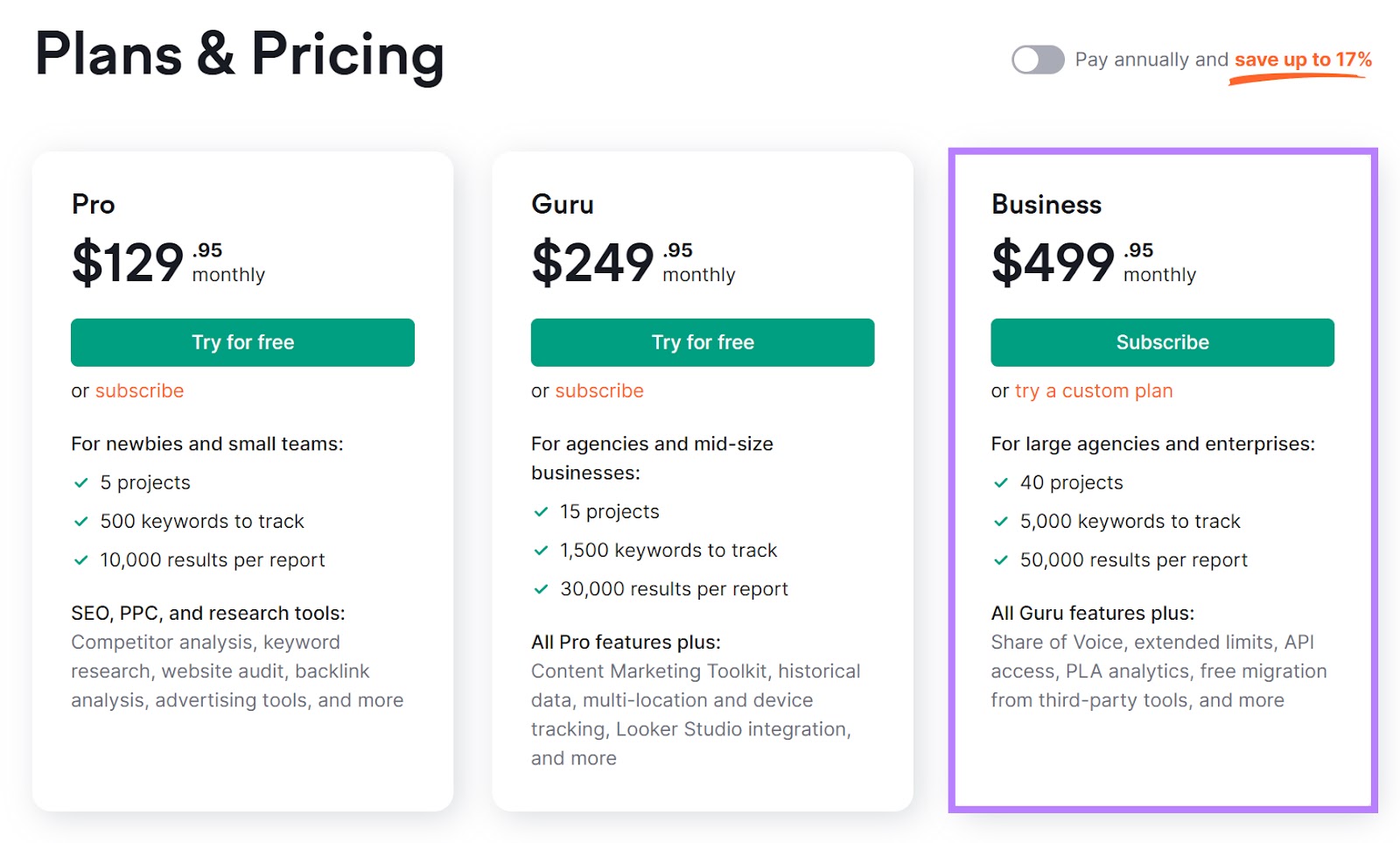
The Business plan is the top-tier plan. It has the most features, highest limitations, and access to additional tools to cater to the needs of these highly scaled, fast-moving enterprises.
There’s also a custom pricing option for businesses that need to go bigger.

Enterprise SEO platforms often offer features that support large-scale operations, such as deeper data analytics, automation capabilities, and integration with other enterprise tools.
Stakeholder Collaboration
Implementing SEO changes in an enterprise environment requires consensus and coordination across multiple departments.
For example, let’s say you’re focusing on improving page speed across the website.
This process often requires extensive coordination and approvals or input across multiple departments. It can be additionally complex if the site operates on a platform requiring custom development work and rigorous testing. Especially if legal departments must review content changes.
Enterprise SEO success can depend significantly on navigating internal bureaucracies and aligning multiple teams with SEO goals. And educating those teams to some degree on SEO in general.
You can try to shorten turnaround times by communicating effectively and demonstrating your SEO strategy’s benefits—and results—to each stakeholder.
Keyword Choice
Thanks to their domain authority and resources, enterprise sites can target a broader range of keywords, including highly competitive terms.
For example, consider a site like Amazon.
With its high domain Authority Score, they’re particularly well-positioned to compete for and rank well with high-volume keywords.
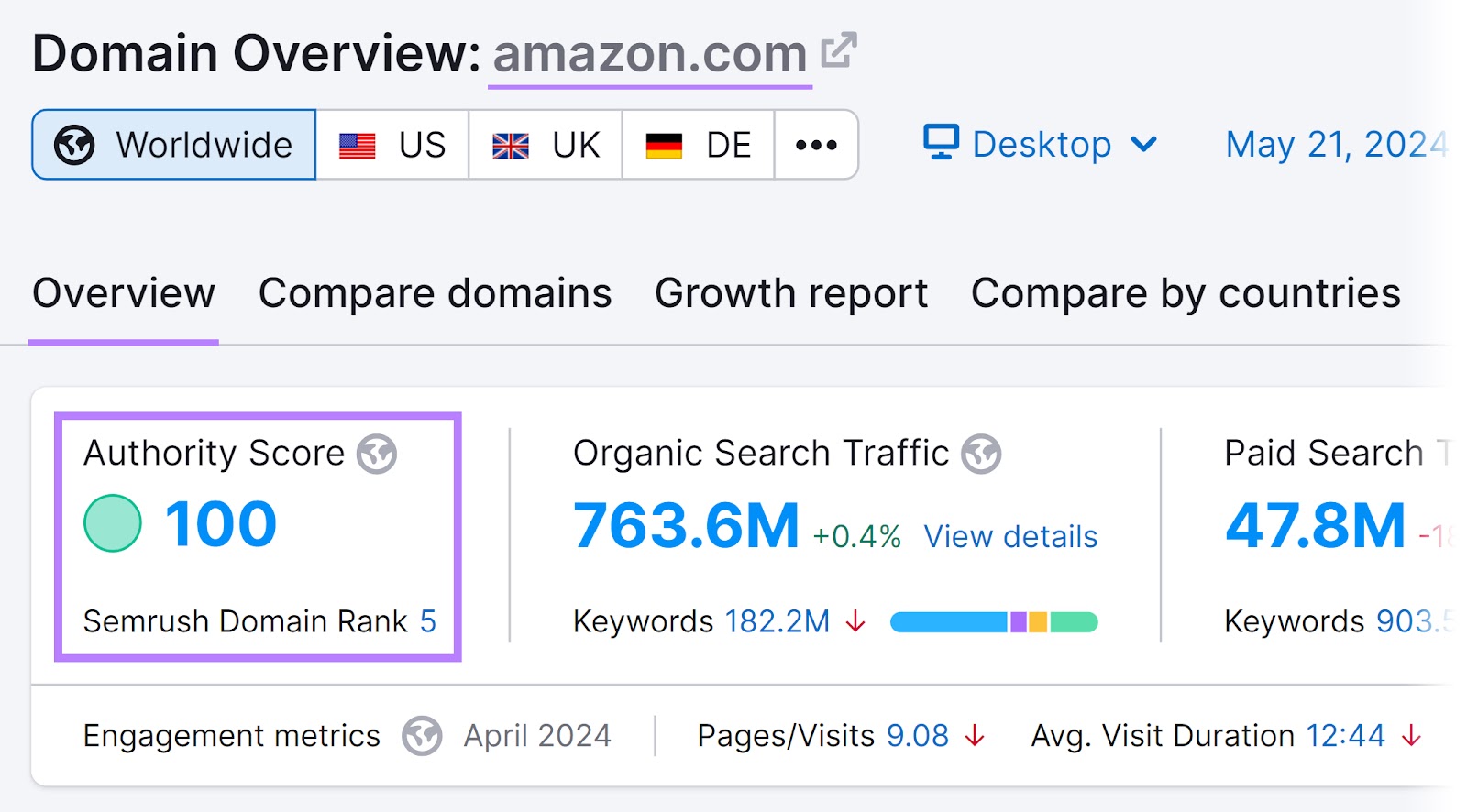
While smaller sites can also compete for these keywords, they may not achieve the same level of effectiveness. They just don’t have the extensive backlink profiles and established brand presence that larger sites like Amazon have.
But here’s the thing:
While enterprise sites can leverage their stature to target broader keywords, they should maintain a balance by targeting niche and long-tail keywords. This approach helps them capture more specific search intents and opportunities.
Webpages
The sheer number of pages on enterprise sites makes them more likely to have challenges like duplicate content and page bloat.
Page bloat is the presence of excessive or unnecessary pages on a website. This can dilute your SEO efforts and consume your crawl budget. These can negatively impact your enterprise site’s overall search performance.
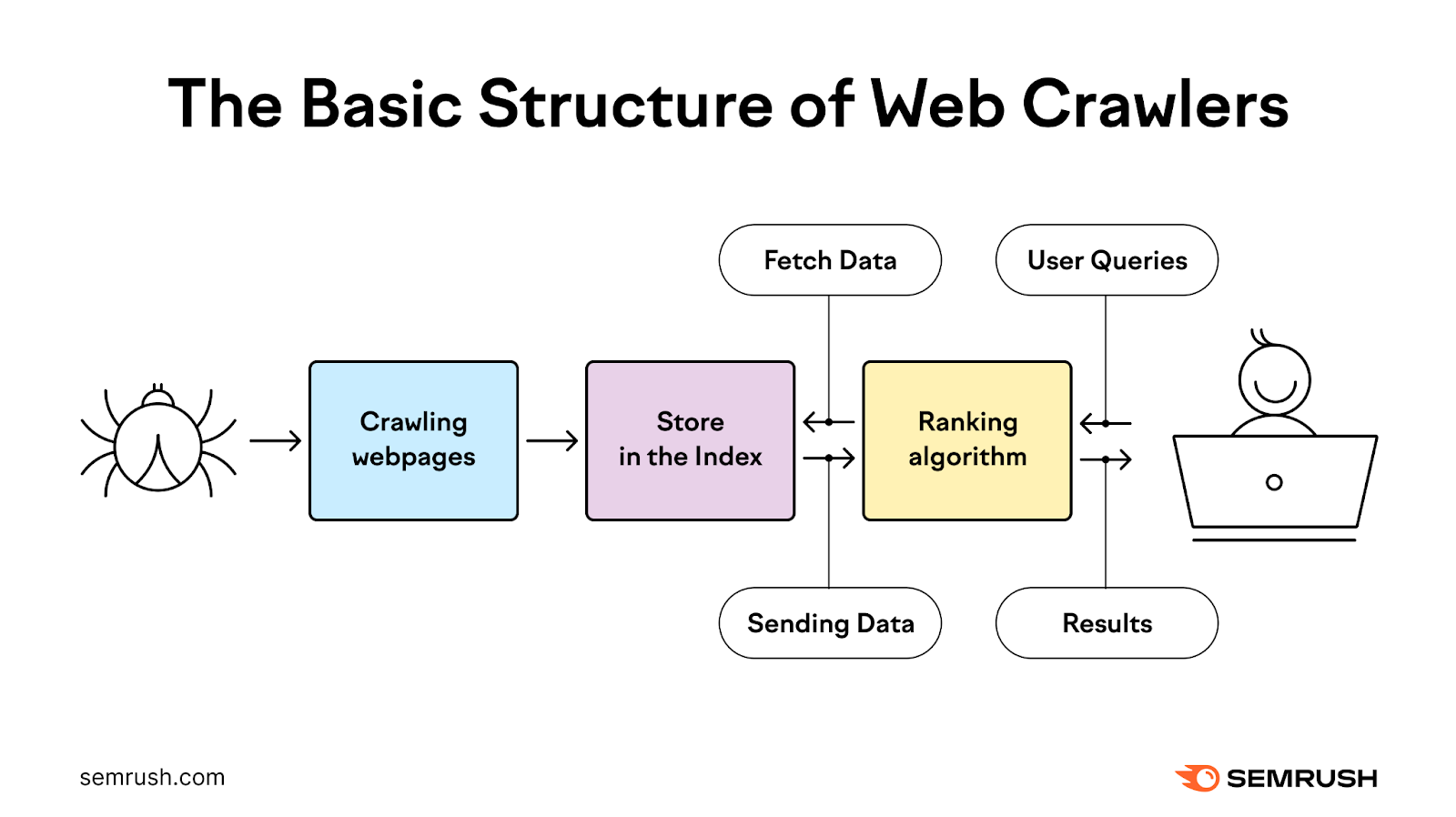
An ecommerce site may have thousands of product pages generated by a content management system (CMS), leading to duplicate content issues. Similarly, a company offering services in multiple locations might struggle with creating unique content for each page.
Managing these challenges requires enterprise SEO that meets large organizations’ needs. Such practices range from advanced use of canonical tags to regular enterprise SEO audits to identify and address issues like page bloat.
Key Advantages of Enterprise SEO
Implementing SEO for enterprise companies can increase their online presence and operational efficiency. Here’s how enterprise SEO will help your business.
Enhanced Brand Visibility
Higher brand visibility increases consumer recognition and trust, potentially contributing to higher traffic and conversion rates.
Enterprise SEO strategies amplify a brand’s presence across multiple digital platforms and search results. This approach helps the brand appear frequently and prominently in relevant searches.
For example, a global electronics company can use targeted keyword strategies to achieve top rankings in search results. They focus on high-competition terms related to electronics. This can increase their brand exposure across various markets.
Scalability of SEO Efforts
Scalability ensures that SEO strategies grow with the company and support its expansion without losing effectiveness.
Enterprise SEO provides a framework that adapts to and supports company growth.
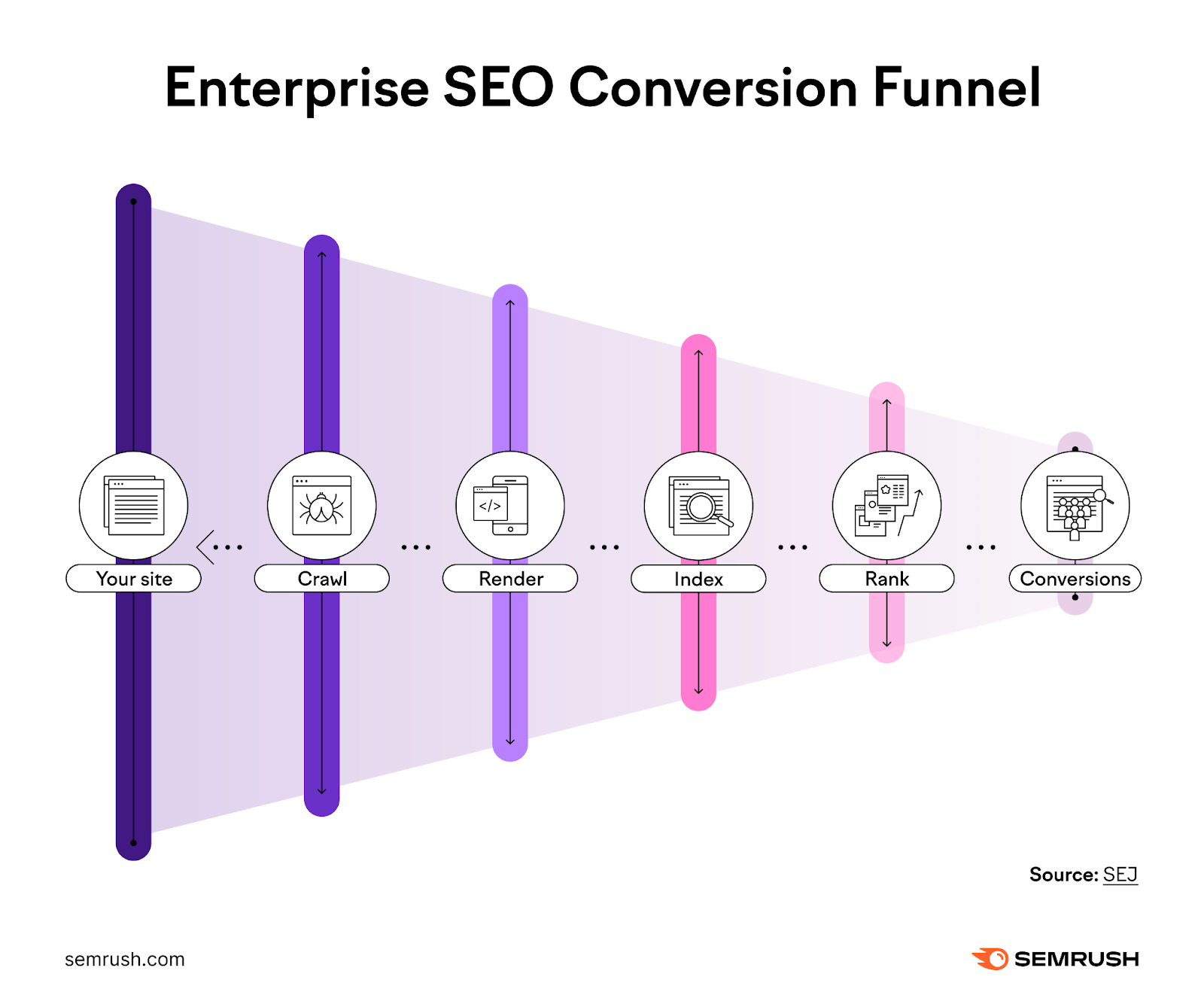
Such growth includes increasing pages and products as well as entering new markets.
Let’s say that a significant online retailer expands its product range and enters new geographic markets. They can use a scalable SEO strategy that includes localizing and optimizing content for regional search trends without sacrificing performance in existing markets.
Consistent and Unified SEO Across Departments
Consistency ensures that all parts of your organization contribute positively to SEO goals. This helps to avoid conflicts and duplication of effort (performing the same task or activity more than once within an organization), which wastes time and resources.
Enterprise SEO strategies require coordination across various departments—marketing, IT, and sales—ensuring that all contribute to a unified SEO approach.
For example, a multinational corporation can implement a standard SEO training program for all content creators. This practice helps everyone to be on the same page so that every piece of content—whether created in the U.S. or Europe—follows the same SEO standards and practices.
Advanced Analytical Insights
Deeper insights enable your organization to make more informed decisions to produce significant competitive advantages.
Enterprise SEO utilizes sophisticated SEO tools and platforms that provide detailed analytics on:
- Performance
- User behavior
- Market trends
Use Semrush’s Site Audit tool to identify underperforming segments of your website. And see recommendations to optimize them to help improve user engagement and conversion rates.

Risk Management in SEO Changes
Managing risks associated with SEO changes prevents potential negative impacts on the site’s ranking and visibility.
Enterprise SEO requires you to carefully plan and test SEO strategies on a large scale. This approach can help you spot potential risks and address them before they affect your website’s SEO performance.
For example, you can test a new algorithm update’s impact on a small section of your website. Or, with new content. Get feedback and adjust so your website doesn’t lose rankings due to the update.
Key Challenges in Enterprise SEO
Enterprise SEO has unique challenges that can impact your company’s online performance—if you don’t address them effectively.
Managing and Optimizing a Vast Number of Pages
Enterprise websites can jeopardize their SEO if they don’t manage their pages correctly.
While the same statement applies to smaller websites, the challenge for enterprise SEO is maintaining SEO quality across thousands (or millions) of webpages. Each page has to meet search engine standards for better ranking.
Regular enterprise SEO audits and updates are crucial here.
Systematically review content to ensure it remains relevant to optimize your website’s performance. Then, update or retire outdated content.
Use Semrush’s Site Audit tool to conduct comprehensive site scans. The tool identifies issues like duplicate content, poor mobile optimization, or slow loading times. And recommends practical solutions.
Here’s how:
Launch Site Audit. Then, enter your domain name and click the “Start Audit” button.

If you’ve created projects on Semrush, choose an existing project, or click the “+ Create project” button.
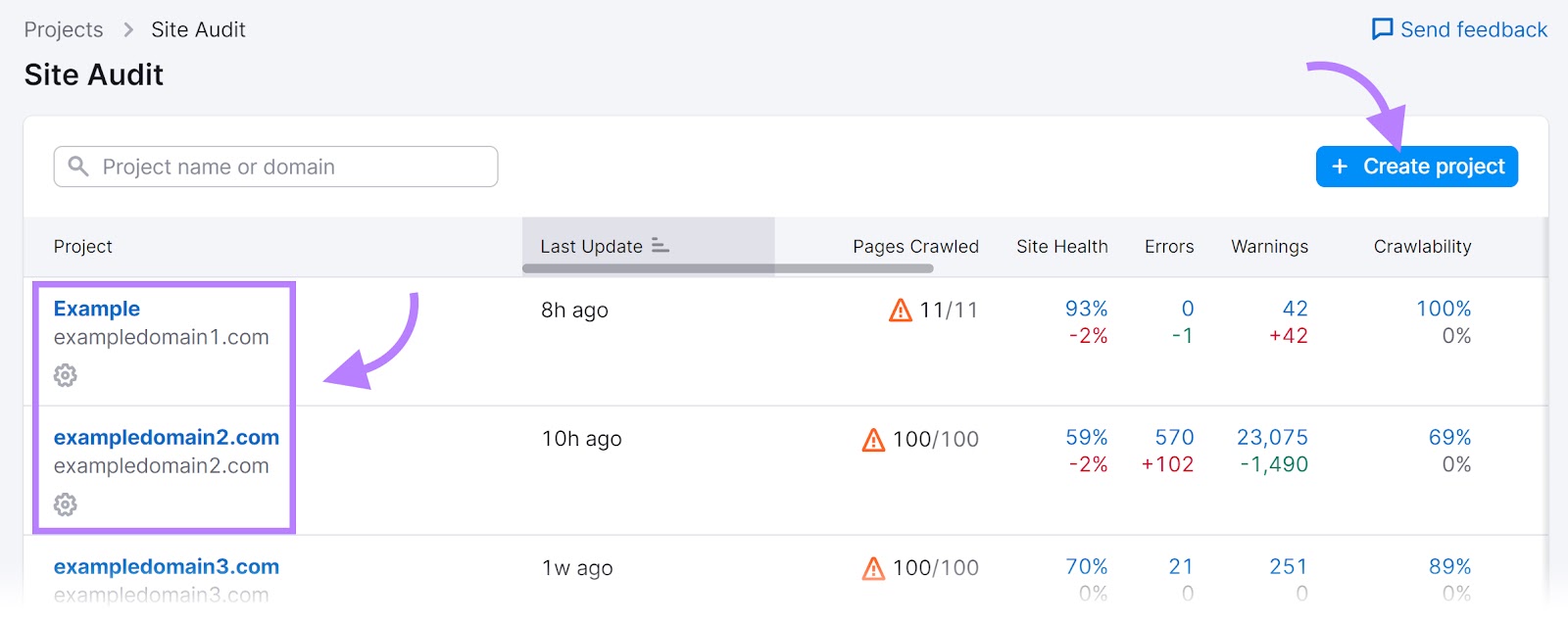
If you are creating a new project, enter your domain in the “Domain” input box and click “Create project.”
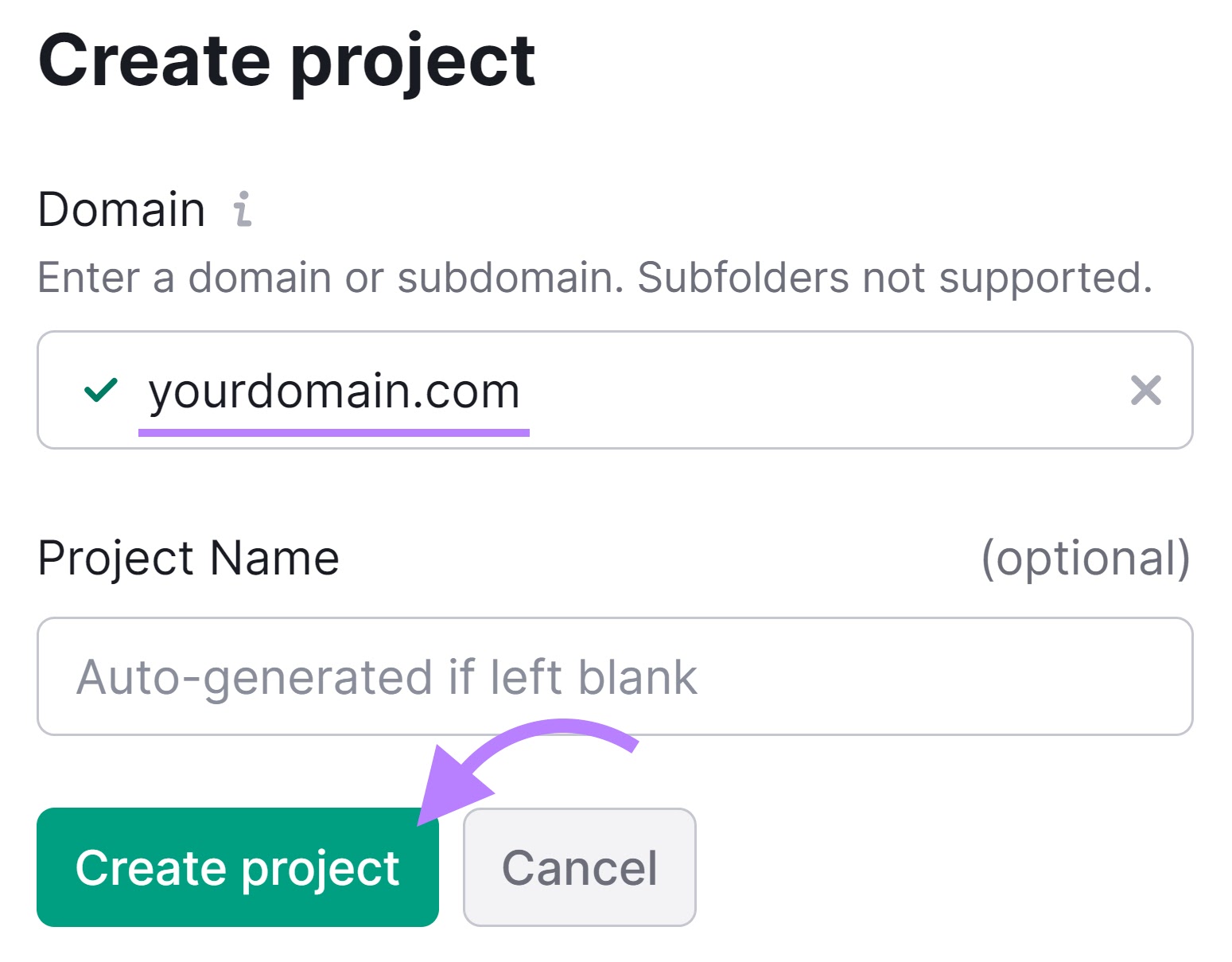
Adjust the configuration settings to fit your preferences.
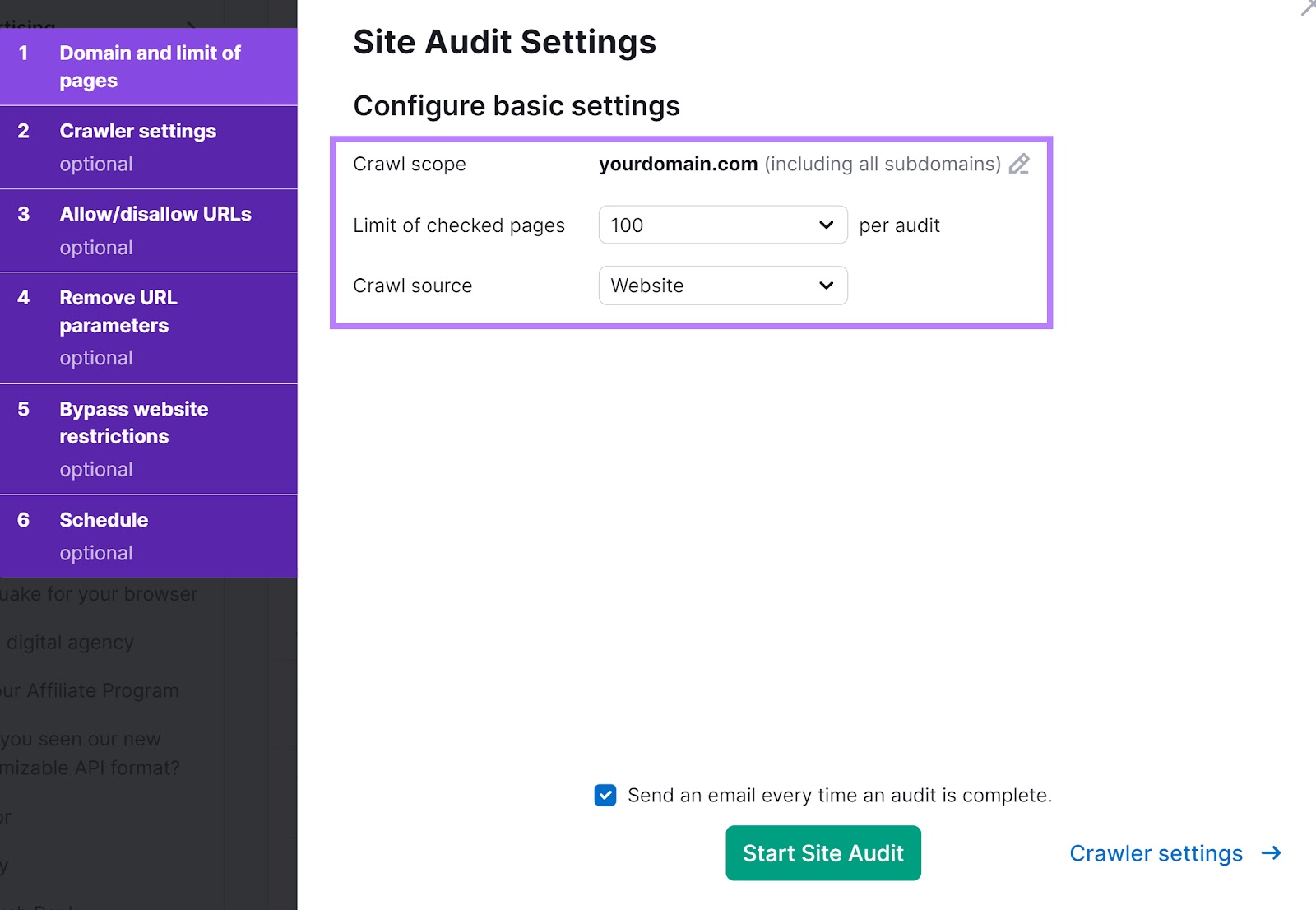
The “Limit of checked pages” drop-down menu allows you to set how many webpages you want to audit. Set the number to meet your enterprise website’s volume.
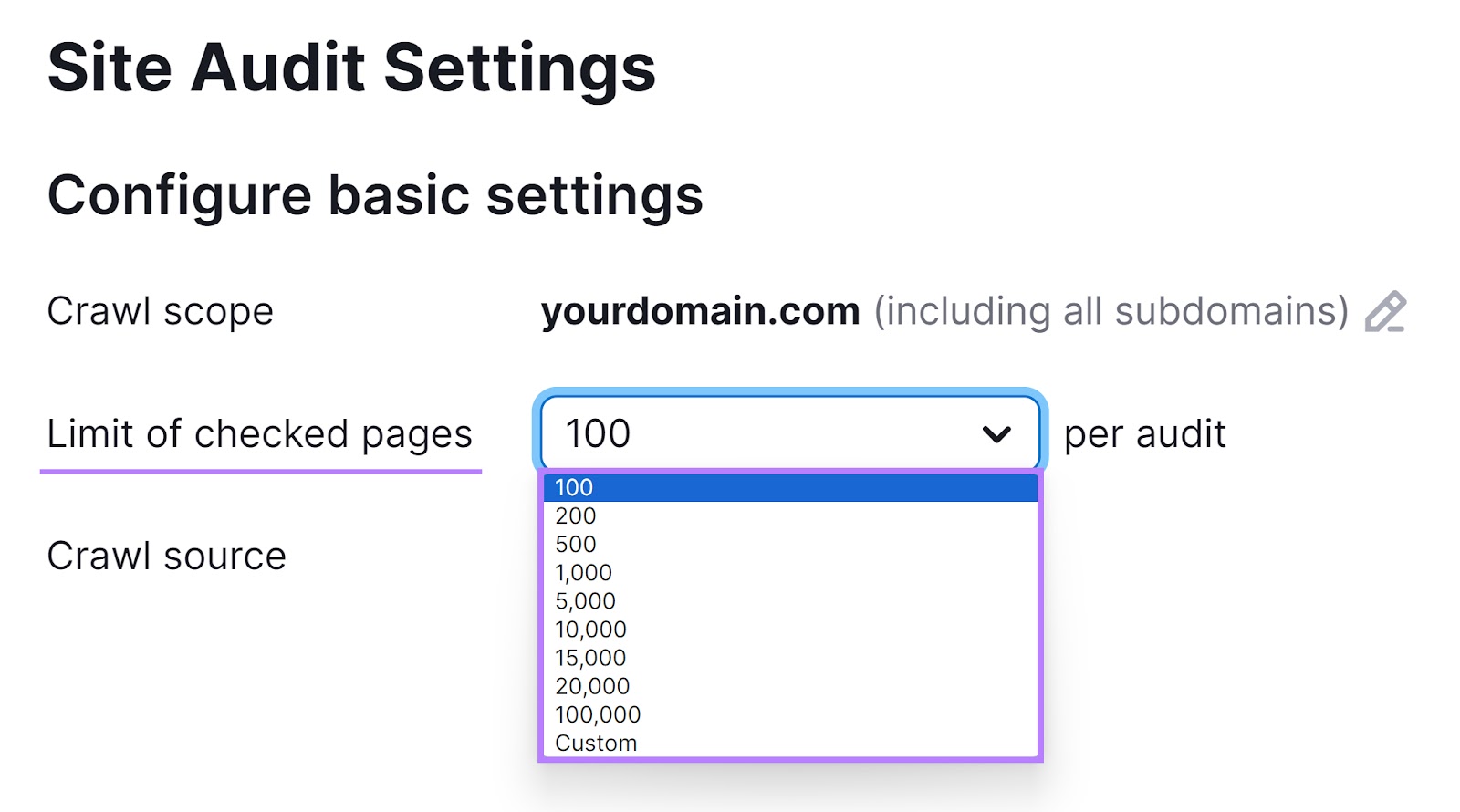
After your settings are configured, click “Start Site Audit.” Check the email option at the bottom of the page to receive an email every time the tool finishes an audit.
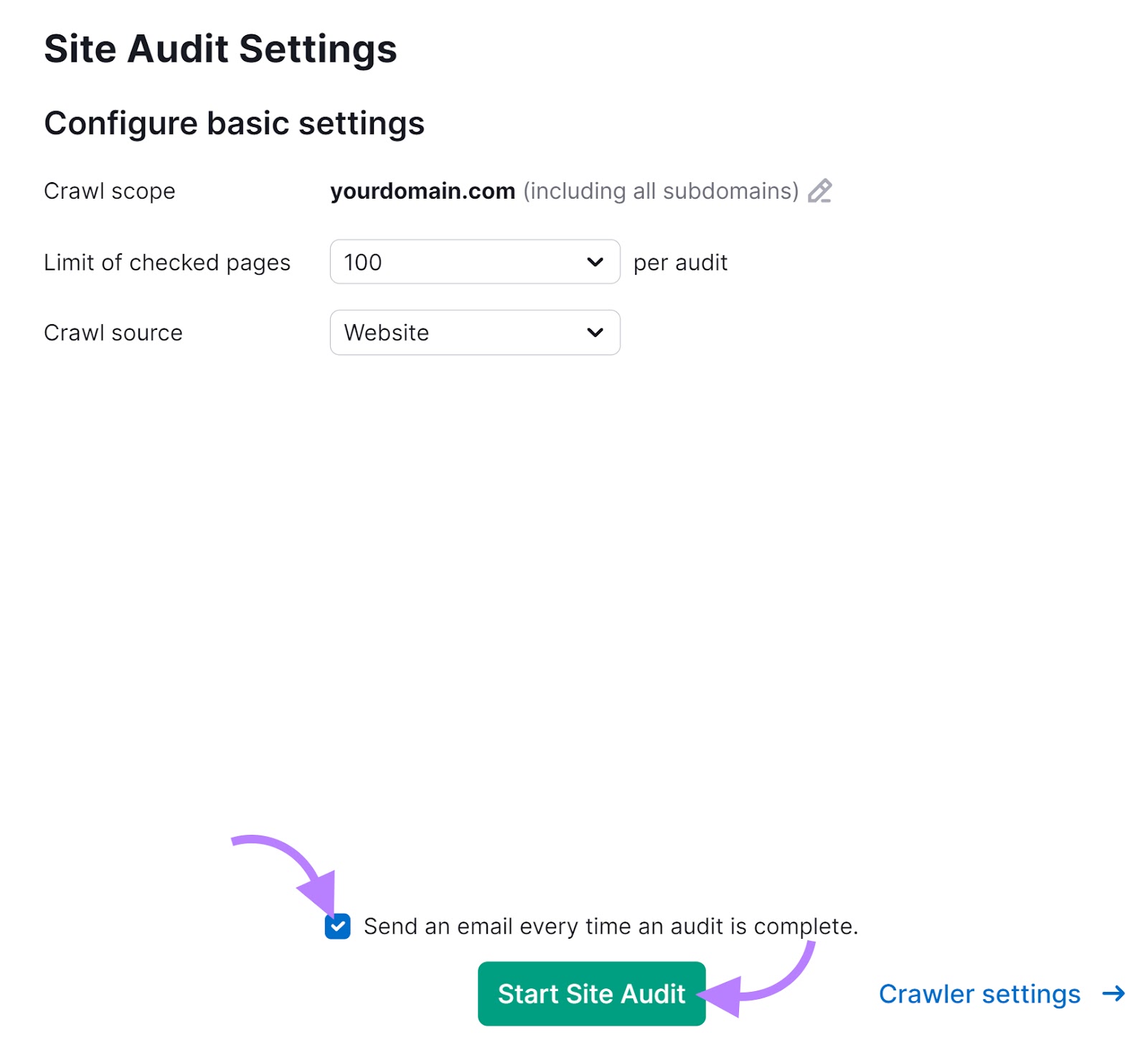
It may take up to 24 hours for larger sites, but you’ll see your report after the tool audits your webpages.
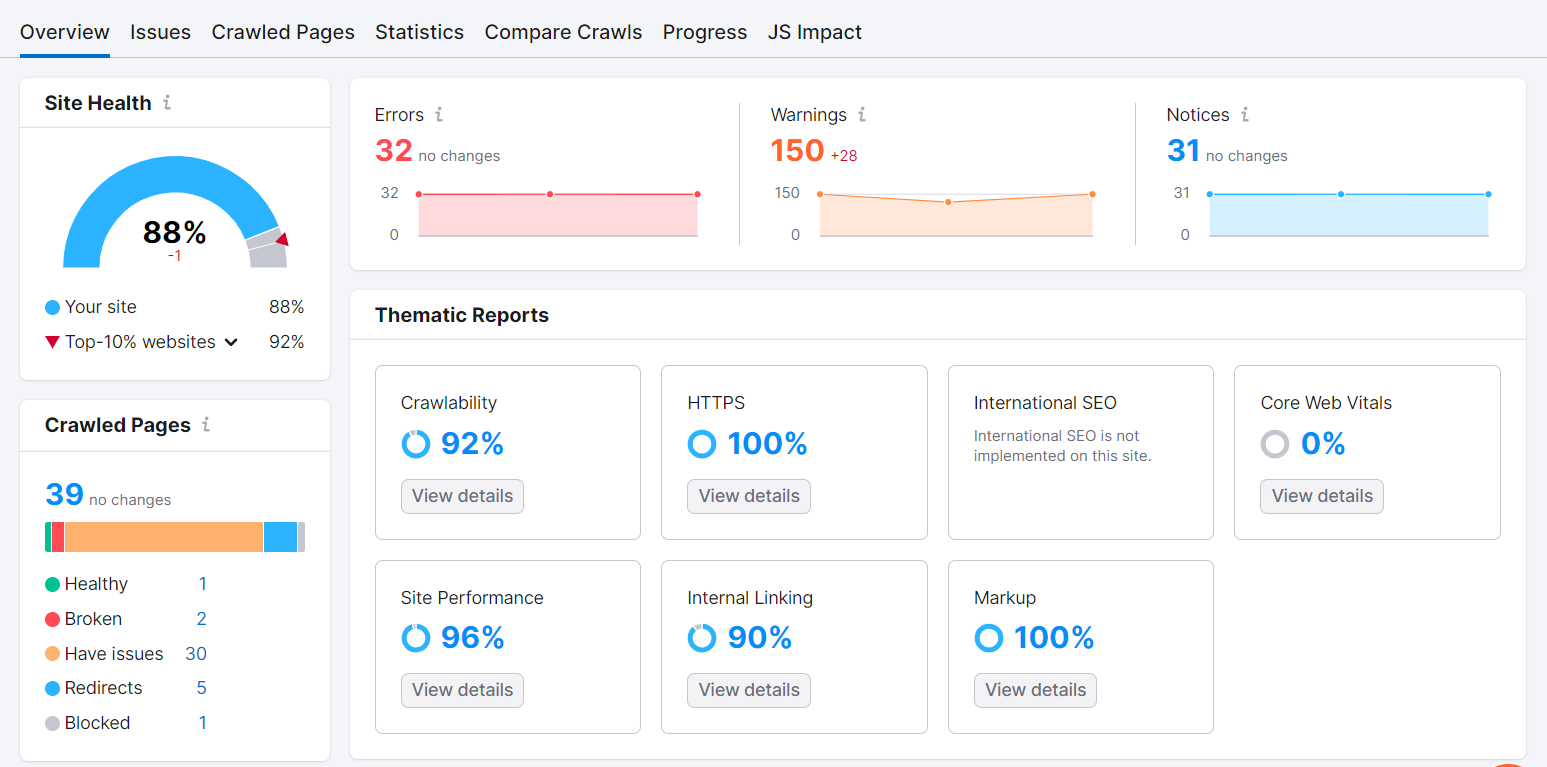
Click the “Issues” tab to view the crawled pages.
Issues have three categories:
- Errors: The most severe issues
- Warnings: These issues have medium severity
- Notices: These are not critical issues, but you should fix them
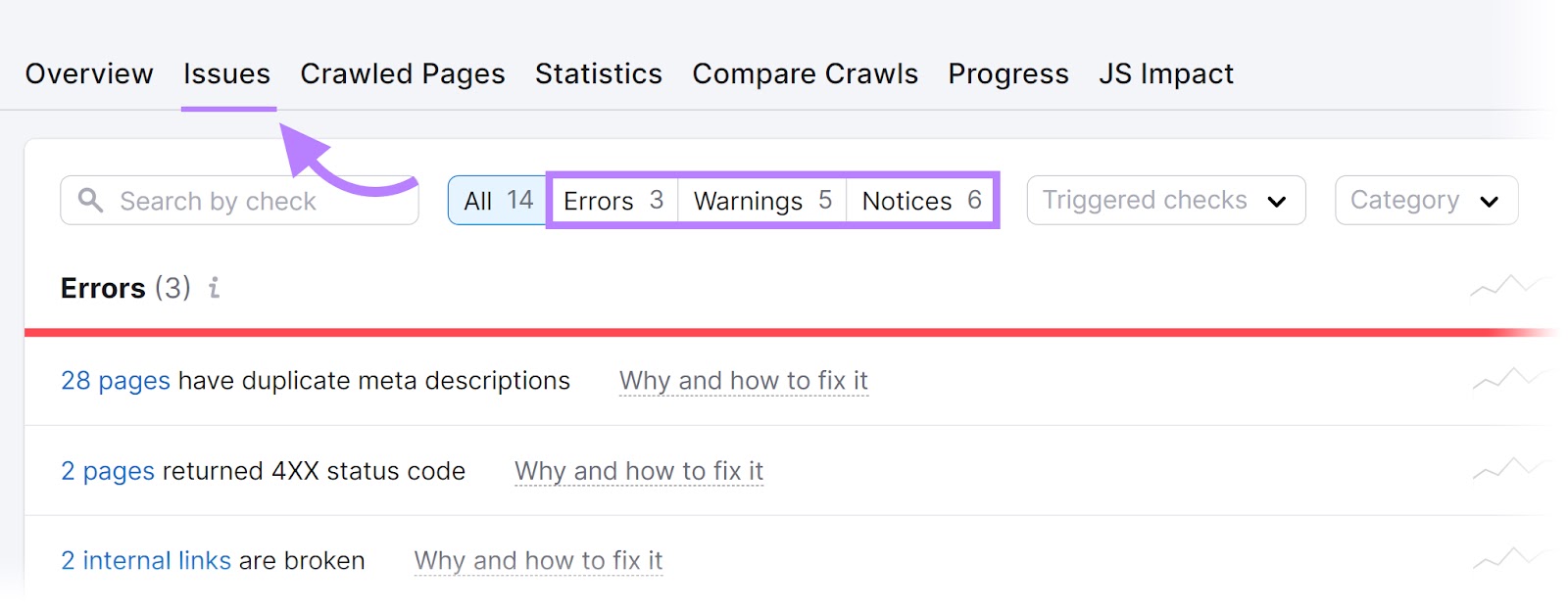
Click “Why and how to fix it” beside an issue for more details.
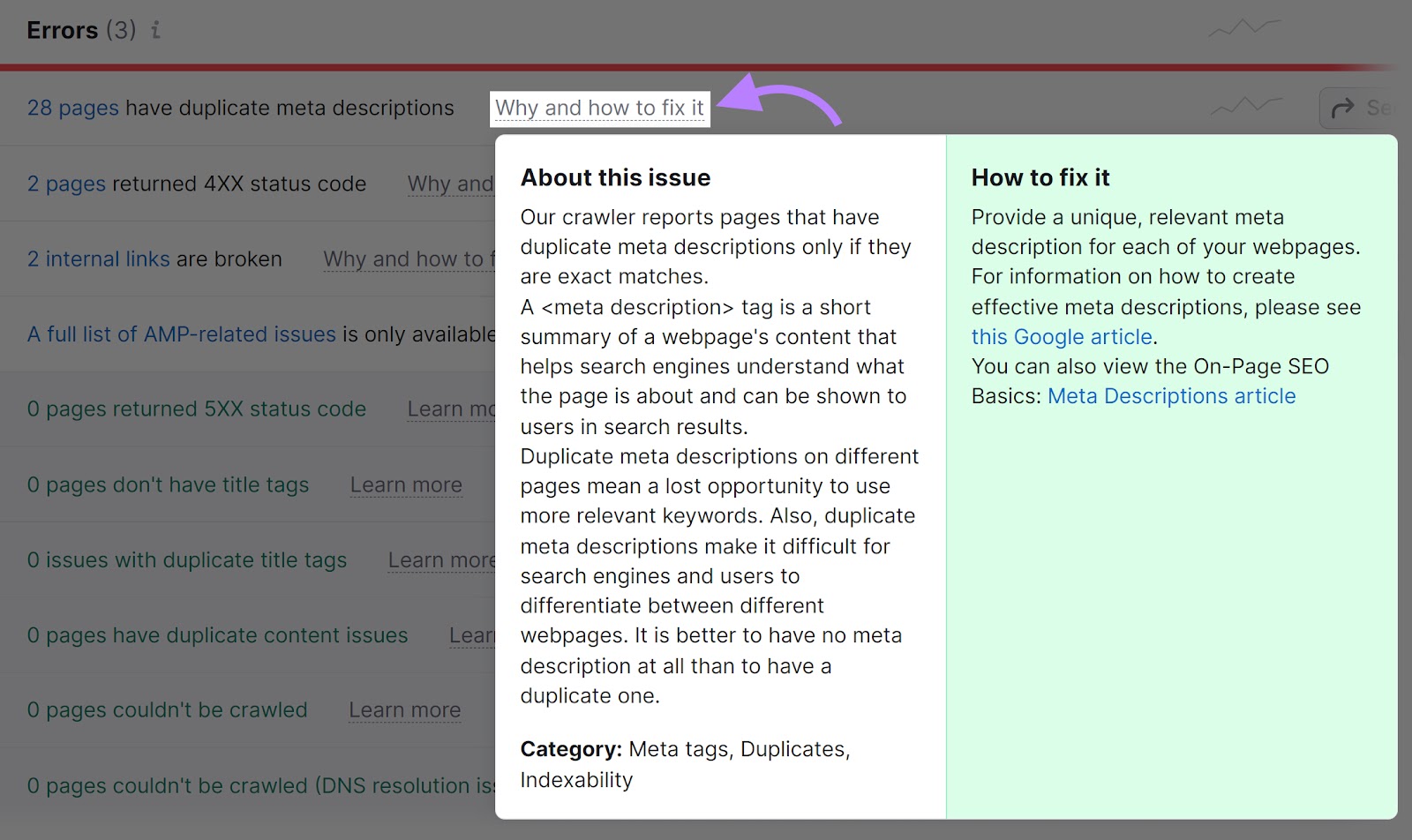
Implementing these recommendations can help improve your website’s performance.
Want to save time? Automate audits with the Site Audit tool.
Click the gear icon in the top-right corner. Under “Site Audit settings,” scroll down to the “Schedule:” option and click on it.
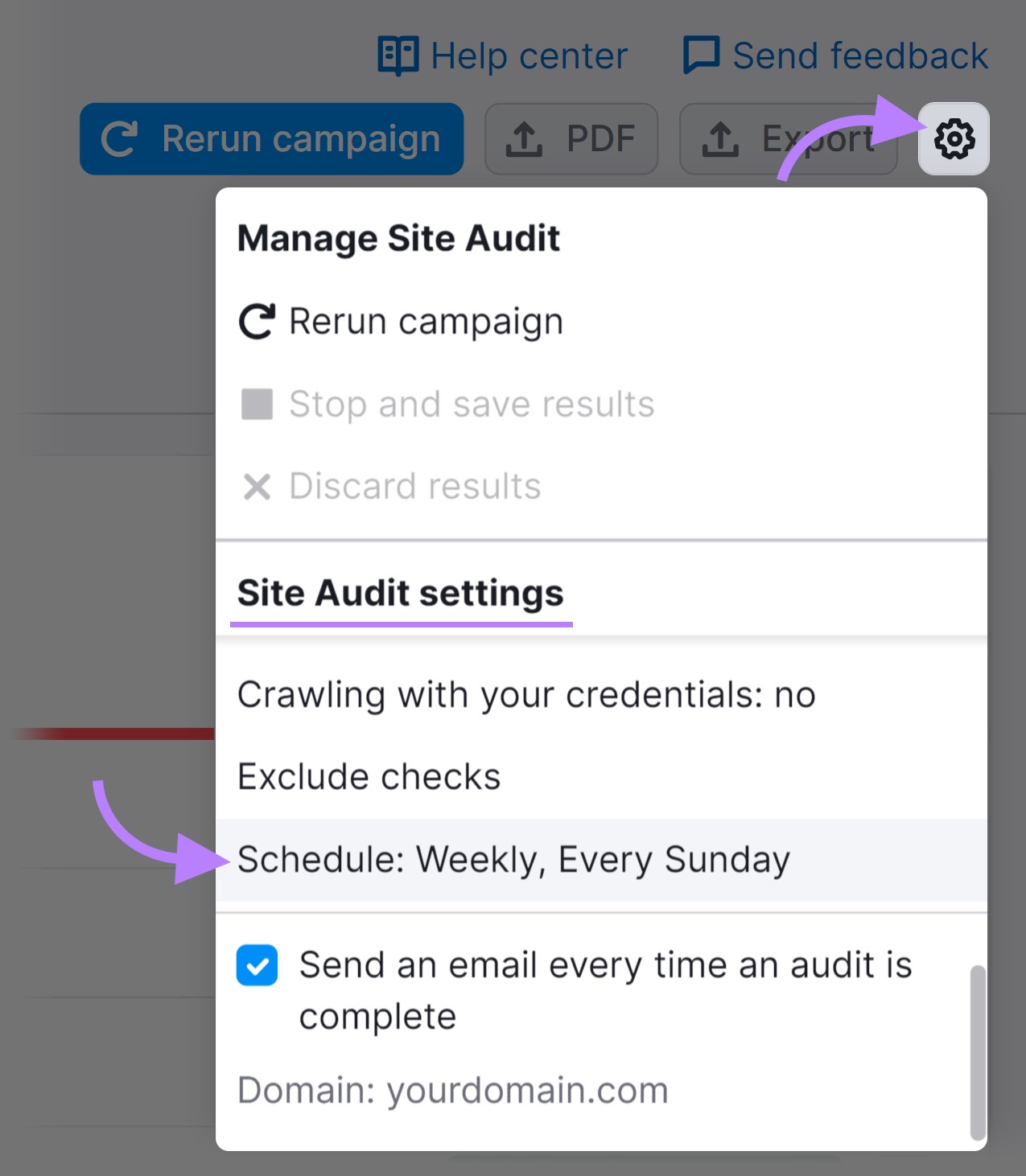
Click the drop-down menu, select your preferred option, and hit the “Save” button.
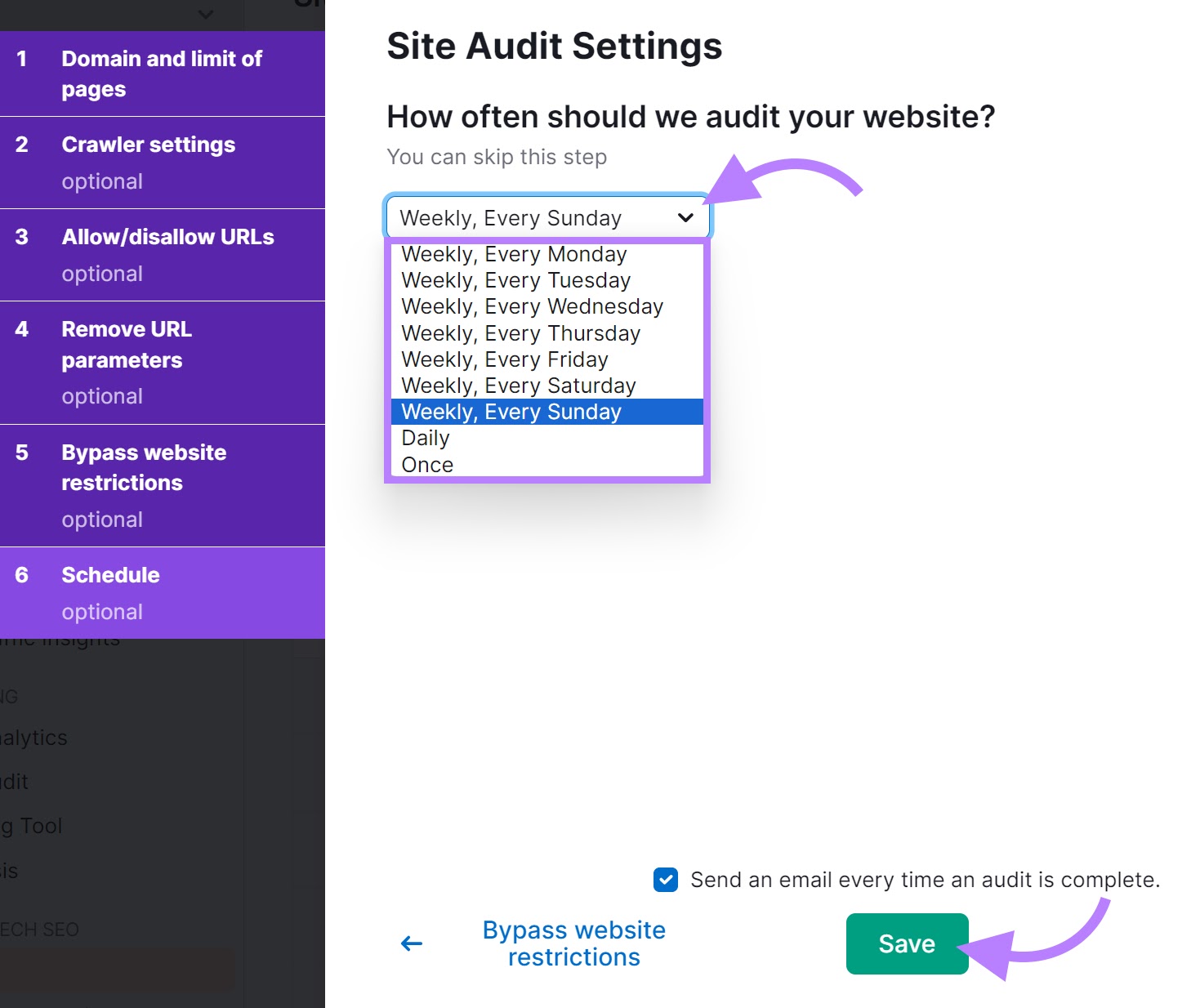
Here’s how to manage and optimize pages on your enterprise-level website:
- Use analytics tools like Google Analytics to identify high-traffic and high-conversion pages as priorities to optimize immediately
- Group similar pages together for batch updates to make large-scale changes more manageable
- Create templates for similar types of pages to ensure consistent SEO practices across the site
- Implement automation tools for tasks like meta-tagging, link updates, and content audits to improve efficiency
- Establish a schedule for regular content reviews and updates to keep pages relevant and engaging
- Train all team members involved in web content management on SEO best practices and your company’s SEO strategy
Further reading: Read our comprehensive guide on how to do an enterprise SEO audit.
Streamlining Site Architecture and Internal Links
Consistent site architecture and a well-planned internal linking scheme can help you effectively distribute page authority across your site.
This challenge involves creating and maintaining a logical structure for your website that supports both scalability and SEO. This approach ensures that new and existing pages are interconnected with the right internal links.
Return to the Site Audit tool to analyze your site’s internal linking structure and identify potential improvements.
Click the “Overview” tab.
Click “View details” in the “Internal Linking” box.

This report includes issues with your internal link structure, such as broken links and URLs with too many characters. You’ll also see the number of internal links and distribution.
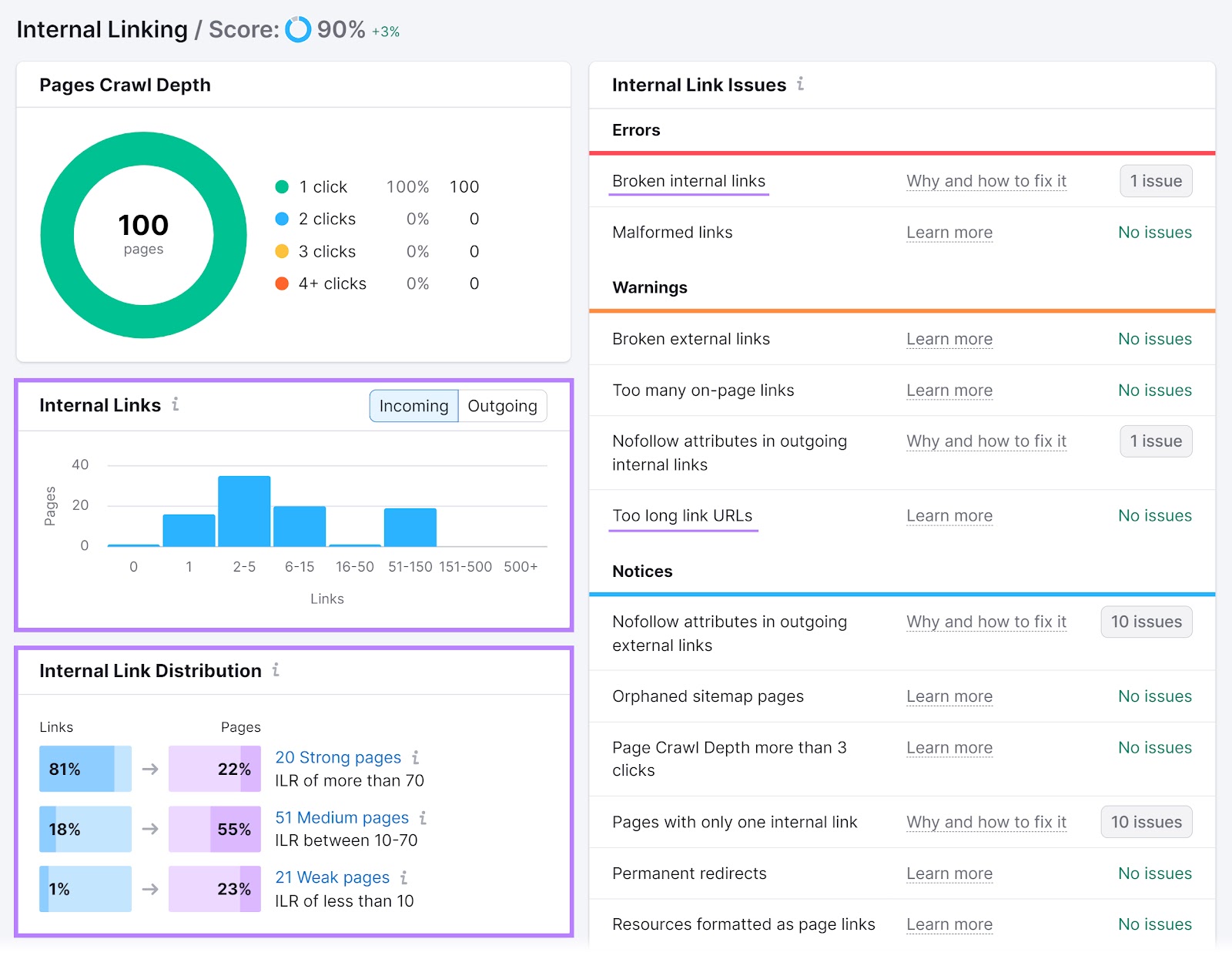
Find issues in the “Internal Link Issues” section. Click on “Why and how to fix it” for an explanation and potential solution.
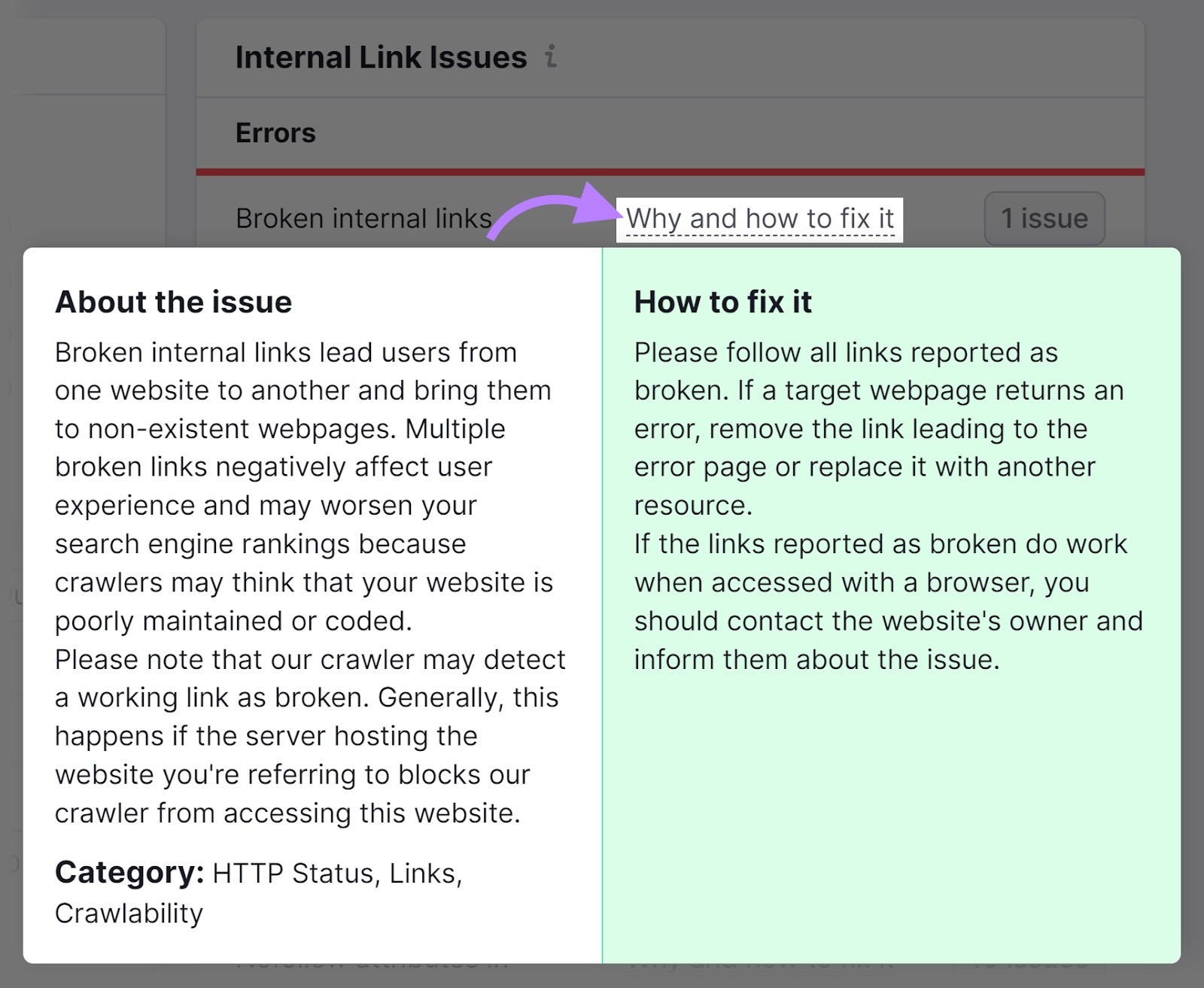
Use these suggestions to improve your internal linking structure.
Here are some tips to maintain a consistent site structure and improve your internal linking:
- Prioritize links: Structure links to reflect the importance of pages so more vital pages receive more internal links
- Use keyword-rich anchors: Ensure that internal links use relevant, keyword-rich anchor texts that inform both users and search engines about the page content they link to. Have a good blend of exact match, phrase match, broad match, and branded anchor text.
- Review regularly: Periodically review your site structure and internal links and update for new content, discontinued products, or changes in business focus
- Add cross-links: Link across categories when relevant to guide users to related content or products. This can increase their time on the site and the pages’ SEO value.
- Manage link count: Keep the number of links on a page reasonable to avoid decreasing link value and confusing both users and search engines
Managing Complex Website Infrastructures and Subdomains
Managing complex website infrastructures and multiple subdomains helps you maintain coherence as you implement your SEO strategy.
Unity across your domains helps amplify your brand’s digital presence.
This challenge focuses on the difficulties of coordinating SEO strategies across various parts of your organization’s digital footprint. It includes multiple subdomains that may cater to different business units or geographic locations.
Tackle it by developing a centralized SEO strategy that covers all subdomains and ensures consistent practices across the entire infrastructure.
Actionable tips to handle complex website infrastructures and multiple subdomains include:
- Consolidate subdomains: Consider which multiple subdomains you can combine to reduce complexity and improve SEO management
- Tailor your strategies: Customize the SEO approach for each subdomain to focus on specific keywords relevant to their unique focus or region
- Perform scheduled audits: Conduct regular SEO audits for each subdomain to ensure they adhere to the central SEO guidelines and perform well individually
- Apply canonical tags: Use cross-domain canonical tags appropriately to avoid duplicate content issues between subdomains
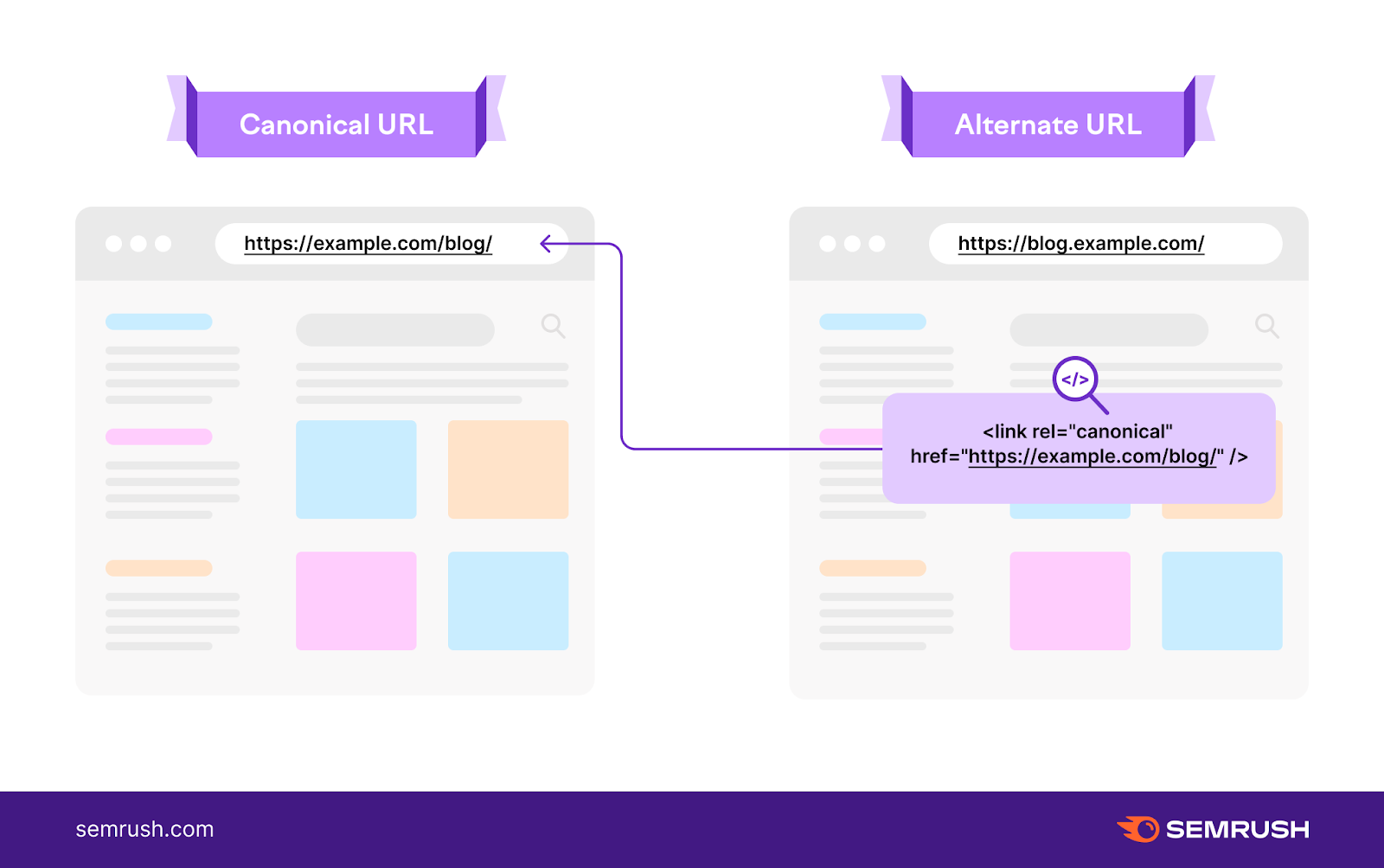
Implementing Scalable Content Strategies
Scalable content strategies in enterprise SEO help you to create and distribute content that adapts to your business’s growth and evolving needs.
This challenge involves building and updating content that aligns with search intent and scales effectively across different regions, languages, and platforms.
Begin with a keyword analysis to identify what’s working and what’s not.
Develop a content strategy that includes creating new pages that match search intent and updating existing content to improve performance. This should be an ongoing process integrated into your content lifecycle.
Here are some practical tips you can use to tackle this challenge:
- Research trends: Use Semrush’s Topic Research tool to uncover what topics are trending in your industry and what questions your audience is asking
- Leverage expertise: Engage subject matter experts within your company to provide insights that enrich content quality and relevancy
- Optimize content: Use the SEO Writing Assistant to generate and optimize your content for SEO
- Syndicate wisely: Consider syndicating top-performing content to extend reach. Ensure that syndicated content follows SEO best practices to avoid duplicate content issues.
- Go global: Translate successful content into other languages to address international audiences
- Boost visibility: Coordinate with social and paid marketing teams to promote content through various channels
Collecting, Analyzing, and Reporting on SEO Data
Effective data management can help you understand SEO performance, guide strategic decisions, and see ROI across different levels of the organization.
Set up integrated systems like Google Analytics (GA4) to collect data across your SEO activities.
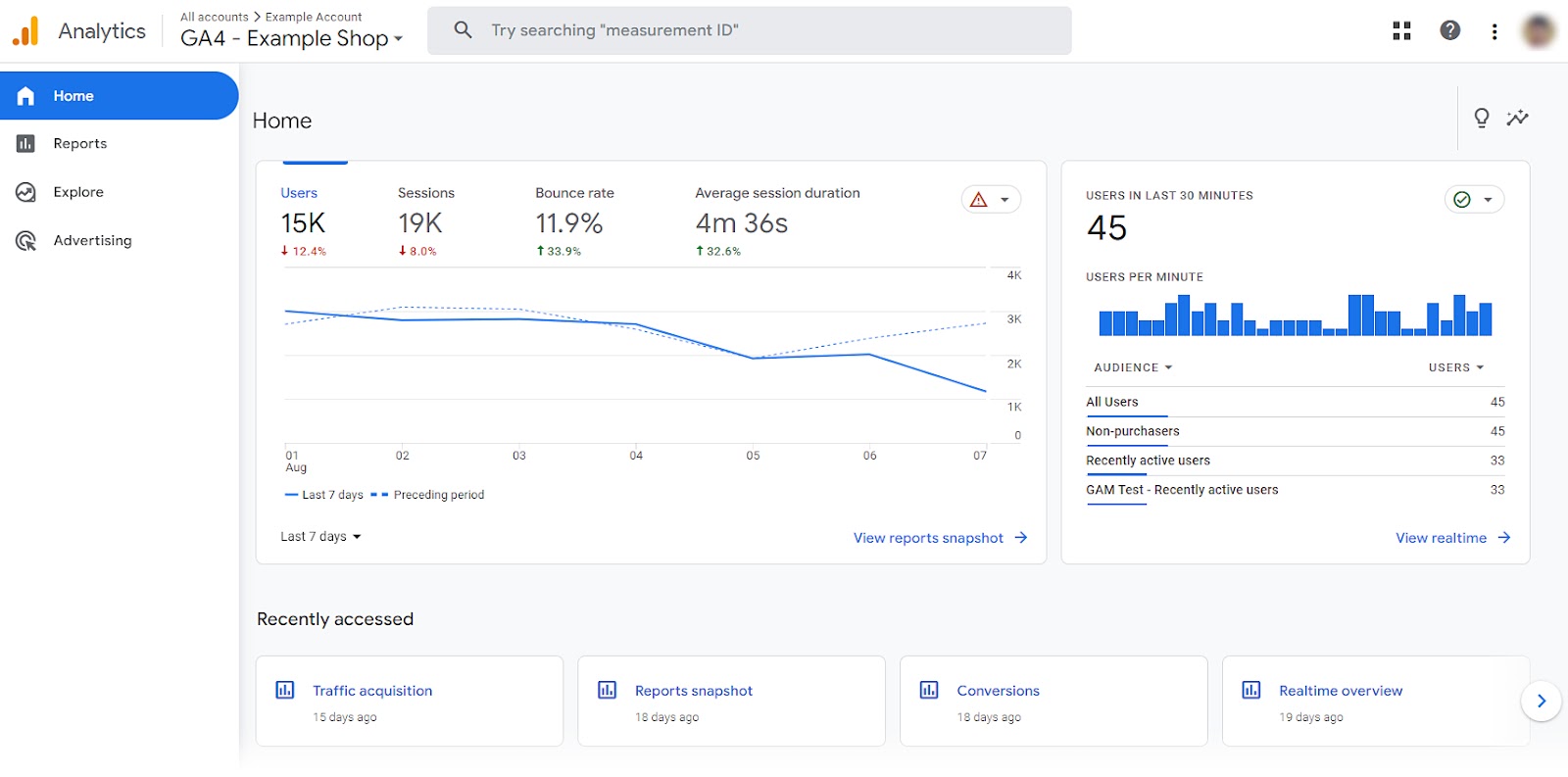
Regularly analyze this data to identify trends, opportunities, and areas that need improvement. Reporting should be routine, with monthly or quarterly reviews depending on the scale and needs of the business.
For example, use advanced analytics to track the performance of your SEO strategy across hundreds of product categories and multiple regions. Then, gather data on keyword rankings, page traffic, and conversion rates. Compile these insights into customized reports for department heads to inform your strategies.
You can:
- Automate data collection: Use tools to automate the collection of SEO data, saving time and minimizing human error. Automation ensures data is consistently and timely updated.
- Segment data: Break down SEO data by department, region, or product line to deliver more relevant insights across the organization
- Define KPIs: Establish clear and actionable KPIs to measure SEO success, focusing on metrics like traffic growth, conversion rates, and improvements in keyword rankings
Coordinating with Multiple Teams and Stakeholders
This challenge involves managing communication and collaboration among different departments and stakeholders who impact SEO directly or indirectly, such as marketing, IT, content teams, and external agencies.
Establish clear communication channels and regular meetings to discuss SEO strategies, updates, and results. Implement a centralized project management tool to keep track of tasks, responsibilities, and deadlines across teams.
Here are some tips to overcome this challenge:
- Clearly define roles and responsibilities for each enterprise SEO team member to prevent overlap and ensure accountability
- Schedule regular update meetings or reports to keep all stakeholders informed about SEO progress and to gather feedback from various perspectives
- Align all teams under shared SEO goals that contribute to the overall business objectives so everyone understands how their work impacts these goals.
- Offer training sessions that include members from different departments to foster a better understanding of how various elements of SEO interconnect
- Implement a structured feedback mechanism to gather insights from all stakeholders. This can help refine strategies and increase engagement across teams.
Choosing an Enterprise SEO Solution
Consider these vital factors to ensure the enterprise SEO platform meets your current and future needs.
|
Key Points |
Example |
|
|
Scalability |
|
Initially tracks thousands, scales to millions of keywords |
|
Pricing |
|
Tiered pricing model, from basic to advanced tiers, with custom pricing option |
|
Integration |
|
Integrates with systems like Google Analytics 4 |
Scalability
Your enterprise SEO solution must grow with your business and handle increasing demands without losing performance.
Scalability means the platform can expand to handle the growing number of tasks an enterprise may require, from tracking millions of keywords to auditing vast websites as demand grows. As your business expands, your SEO needs will evolve. A platform that can handle the increased complexity and volume will promote your business’s growth.
Consider a multinational corporation that initially tracks several thousand keywords. As they expand into new markets, their keyword **** can encompass several million.
A scalable SEO platform can manage increased demand, allowing for consistent monitoring and analysis of all keywords. Seek features that automate resource scaling and offer modular upgrades to accommodate growing data volume and complexity.
Pricing
Choose an SEO platform that offers cost-effective solutions, ensuring your investment is sustainable. Evaluate the platform’s cost in relation to its features and scalability to align with your budget.
For example, you can choose a platform with a tiered pricing model starting with a basic package. As your SEO needs grow and become more complex, upgrade to higher tiers with advanced features and greater capacity for data processing.
The best pricing ****** in enterprise SEO solutions offer flexibility and scalability with custom pricing options. This allows you to adjust your subscription based on what you use and need. Rather than locking you into costly packages with features you don’t require.
Integration with Existing Workflows
Seamless integration means your SEO platform complements and improves your marketing workflows without disruption.
This involves how well the enterprise SEO solution works with your current business systems and software, such as content management systems and analytics tools.
For example, you can use an enterprise SEO platform that integrates with Google Analytics.
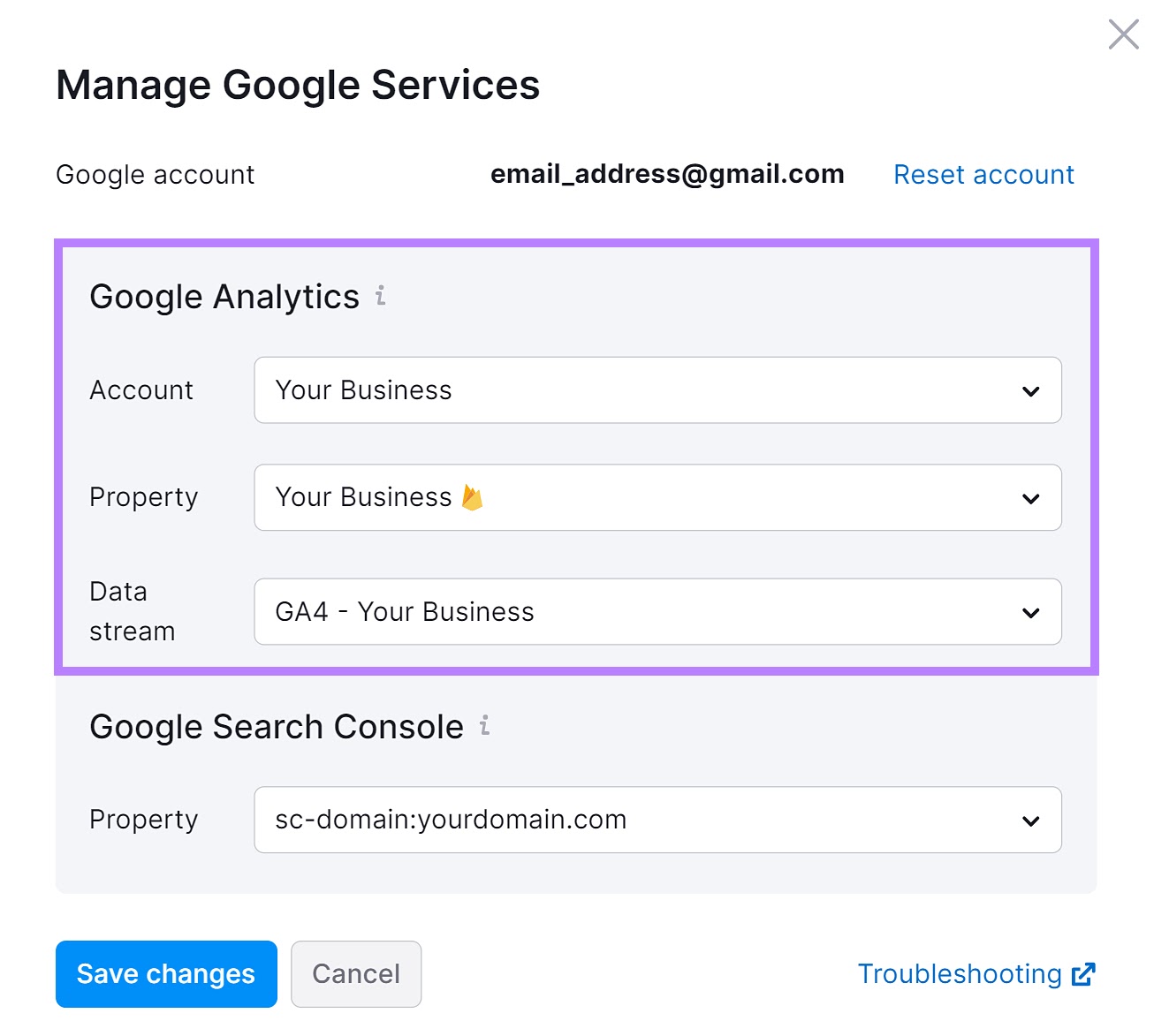
This integration allows you to share data and real-time insights to adjust SEO strategies based on current performance data quickly.
The ideal SEO platform should offer APIs and plugins that support easy integration with various systems. This way, it can fit into your current marketing tech stack and adapt to new technologies and platforms.
Advanced Features and Technology
Advanced features like an AI assistant help you use the latest technology to provide deeper insights and more effective SEO strategies.
Such features include AI-driven analytics, automated content updates, and predictive insights that help you anticipate market trends and adapt strategies accordingly.
For instance, let’s say you’re a fashion retailer.
An enterprise SEO platform that uses machine learning might help you to identify and predict upcoming fashion trends. It may also provide automated suggestions on relevant keywords and content updates.
Besides AI and machine learning, other advanced features might include:

These features provide a competitive edge by automating complex tasks and providing insights that you may not see through traditional analysis methods.
Further reading: Read our guide on how to choose an enterprise SEO platform.
Optimize Your Online Presence With Enterprise SEO
Now, you understand the essentials of enterprise SEO. But the real journey begins with applying these strategies to your organization.
Unlock the full potential of your enterprise SEO efforts with Semrush’s suite of tools tailored specifically for businesses like yours.
Start by using the Site Audit tool to assess your current SEO practices and identify areas for improvement.
Sign up for a free trial today and begin making informed decisions to optimize your enterprise SEO strategy for success.
FAQs
How Much Does Enterprise SEO Cost?
The cost of enterprise SEO depends on several factors, like the size of your business, the scope of services you require, and the specific goals of the SEO campaign. Plus, the cost that the enterprise SEO platform offers.
Generally, enterprise SEO services can range from $11,500 to $21,500 per month. This pricing covers basic services like audits and comprehensive, full-service SEO strategies with advanced AI content analysis.
Consider the potential ROI from SEO investments. And choose a service level that aligns with your business’s objectives and budget.
Is Enterprise SEO Necessary?
Yes, enterprise SEO is essential if your organization needs to maintain and improve online visibility and search rankings across a large, complex website—especially as it scales.
It helps large organizations to maintain visibility and ranking in search engines. It also supports branding, drives traffic, and improves your user experience on a scale typical SEO cannot.
Without enterprise SEO, large organizations risk losing competitive edge and visibility to smaller, more agile competitors.
What Are the First Steps in Developing an Enterprise SEO Strategy?
Building an enterprise SEO strategy begins with a comprehensive audit of your current SEO performance and digital assets. This includes:
- Reviewing your site structure, content quality, link profile, and keyword performance
- Setting clear goals aligned with business objectives, such as increasing organic traffic, improving conversion rates, or expanding into new markets
- Collaborating with stakeholders across various departments to ensure the SEO strategy integrates seamlessly with overall marketing and IT operations
Source link : Semrush.com
